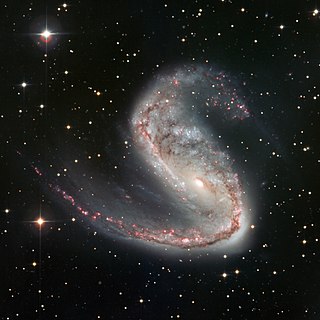Top Qs
Timeline
Chat
Perspective
NGC 2442 and NGC 2443
Galaxy in the constellation Volans From Wikipedia, the free encyclopedia
Remove ads
NGC 2442 and NGC 2443 are two parts of a single intermediate spiral galaxy, commonly known as the Meathook Galaxy or the Cobra and Mouse.[3] It is about 50 million light-years away in the constellation Volans. It was discovered by Sir John Herschel on December 23, 1834 during his survey of southern skies with a 18.25 inch diameter reflecting telescope (his "20-foot telescope") from an observatory he set up in Cape Town, South Africa.[4] Associated with this galaxy is HIPASS J0731-69, a cloud of gas devoid of any stars.[5] It is likely that the cloud was torn loose from NGC 2442 by a companion.[5]
When John Louis Emil Dreyer compiled the New General Catalogue of Nebulae and Clusters of Stars he used William Herschel's earlier observations that described two objects in a "double nebula", giving the northern most the designation NGC 2443 and the southernmost most the designation NGC 2442. Herschel's later observations noted that the two objects were actually a single large nebula.[4][6]
Remove ads
Supernovae
Two, or perhaps three, supernovae have been observed in NGC 2442:
- SN 1999ga (Type II, mag. 18) was discovered by the Perth Astronomical Research Group on 19 November 1999.[7][8]
- SN 2015F (Type Ia, mag. 16.8) was discovered by Libert "Berto" Monard on 9 March 2015.[9][10] It reached magnitude 12.9, making it the brightest supernova of 2015.[11]
- Gaia16cfr, also known as AT 2016jbu,[12][13] was a supernova imposter that occurred in NGC 2442 on 1 December 2016. It reached a Gaia apparent magnitude of 19.3 and absolute magnitude of about −12.[14] However, a paper published in August 2022 suggested that this was a genuine, but strange, supernova.[15]
Remove ads
References
External links
Wikiwand - on
Seamless Wikipedia browsing. On steroids.
Remove ads

